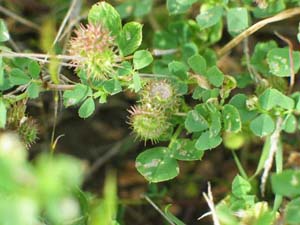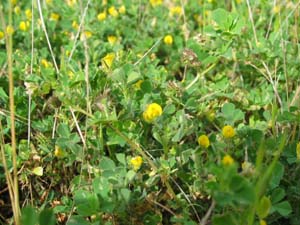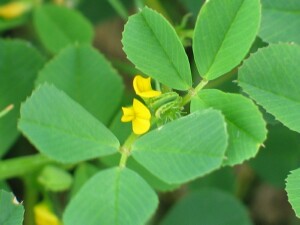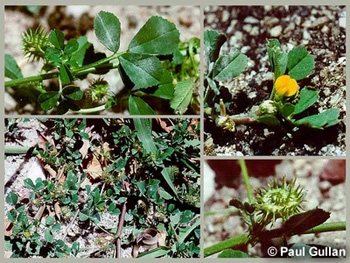Burr Medic
Back | Salinity Indicator Plants Home | Common name home | Scientific name home | Photo Gallery | Glossary
Family: Pea (Fabaceae syn. Papilionaceae) |
| Scientific Name: | Medicago polymorpha | ||||||
Other Common Names: | Trefoil, Toothed Medic, Creeping Burr, Medic Burr, Rough Medic | ||||||
Status: | Native to the Mediterranean but found throughout the world. | ||||||
Plant Description: | Prostrate annual forb, with stems to 50 cm long, sometimes twining, and growing erect when mixed with taller plants (to around 10 cm tall). Leaves each composed of three leaflets borne on short stalks at the end of the main leaf stalk, the terminal leaflet on a longer stalk than the other two. Leaflets wedge shaped, 8 – 20 mm long and 7-15 mm broad, blunt at the tip, the margins finely toothed towards the tip. Flowers yellow and pea-like, 3 – 6 mm long. Fruit is a pod, disc-like or cylindrical, 3 –4 mm diameter, covered with slender spreading and mostly hooked spines to 4 mm long which are often soft when mature. Flowering spring | ||||||
Habitat: | Found in a wide variety of vegetation communities ranging from open grasslands to shrublands and woodlands, and grows on a wide range of soils, but does best in alkaline soils. Grows most prolifically on heavy clays.
| ||||||
Comments: | Burr Medics, and particularly the more recently developed spineless cultivars, are often sown in annual rainfall environments; proving to provide good tolerance in moderately saline situations. |
 Burr Medic fruit Photo: A J Brown |  Burr Medic plant Photo: A J Brown |
 Leaves and flowers of Burr Medic Photo: A J Brown |



